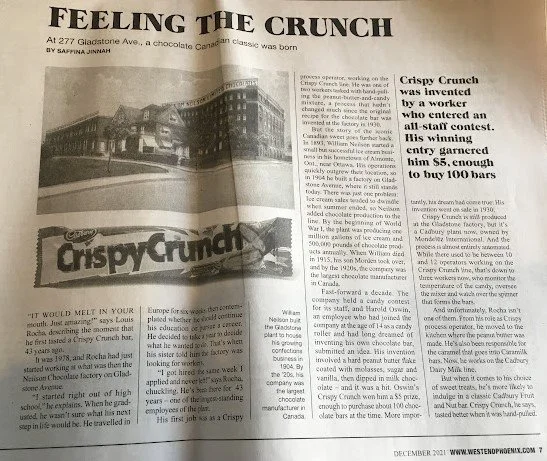FEELING THE CRUNCH
At 277 Gladstone Ave., a chocolate Canadian classic was born.
By Saffina Jinnah
“It would melt in your mouth… Just amazing,” says Louis Rocha, describing the moment that he first tasted a Crispy Crunch bar, 43 years ago.
It was 1978, and Rocha had just started working at what was then the Neilson Chocolate factory on Gladstone Avenue.
“I started right out of high school,” he explains. When he graduated, he wasn’t sure what his next step in life would be. He travelled in Europe for six weeks, then contemplated whether he should continue his education or pursue a career. He decided to take a year to decide what he wanted to do. That’s when his sister told him the factory was looking for workers.
“I got hired the same week I applied and never left!” says Rocha, chuckling. He’s been there for 43 years – one of the longest-standing employees of the plant.
His first job was as a Crispy process Operator, working on the Crispy Crunch line. He was one of two workers tasked with hand-pulling the peanut-butter-and-candy mixture, a process that hadn’t changed much since the original recipe for the chocolate bar was invented at the factory in 1930.
But the story of the iconic Canadian sweet goes further back. In 1893, William Neilson started a small but successful ice cream business in his hometown of Almonte, Ont., near Ottawa. His operations quickly outgrew their location, so in 1904 he built a factory on Gladstone Avenue, where it still stands today. There was just one problem: Ice cream sales tended to dwindle when summer ended, so Neilson added chocolate production to the line. By the beginning of Word War I, the plant was producing one million gallons of ice cream and 500,000 pounds of chocolate products annually. When William died in 1915, his son Morden took over, and by the 1920s, the company was the largest chocolate manufacturer in Canada.
Fast forward a decade. The company held a candy contest for its staff, and Harold Oswin, an employee who had joined the company at the age of 14 as a candy roller and had long dreamed of inventing his own chocolate bar, submitted an idea. His invention involved a hard peanut butter flake coated with molasses, sugar and vanilla, then dipped in milk chocolate—and it was a hit. Oswin’s Crispy Crunch won him a $5 prize, enough to purchase about 100 chocolate bars at the time. More importantly, his dream came true: His invention went on sale in 1930.
Crispy Crunch is still produced at the Gladstone factory, but it’s a Cadbury plant now, owned by Mondelēz International. And the process is almost entirely automated. While there used to be between 10 and 12 operators working on the Crispy Crunch line, that’s down to three workers now, who monitor the temperature of the candy, oversee the mixer and watch over the spinner that forms the bars.
And unfortunately, Rocha isn’t one of them. From his role as Crispy process operator, he moved to the kitchen where the peanut butter was made. He’s also been responsible for the caramel that goes into Caramilk bars. Now he works on the Cadbury Dairy Milk line.
But when it comes to his choice of sweet treats, he’s more likely to indulge in a classic Cadbury Fruit and Nut bar. Crispy Crunch, he says, tasted better when it was hand-pulled.

